Dehydration of alcohols - Study guides, Class notes & Summaries
Looking for the best study guides, study notes and summaries about Dehydration of alcohols? On this page you'll find 182 study documents about Dehydration of alcohols.
Page 2 out of 182 results
Sort by
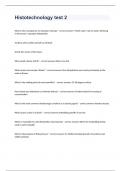
-
Histotechnology test 2 2024 updated to pass
- Exam (elaborations) • 19 pages • 2024
-
Available in package deal
-
- $17.99
- + learn more
Histotechnology test 2 What is the consequence to improper clearing? - correct answers "Moth eaten" due to water still being in the tissues- improper dehydration Sections will crumble and fall out of block Shrink the centre of the tissue Why would a tissue shrink? - correct answers Wax is too hot What causes microscopic chatter? - correct answers Over dehydration seen most prominately at the ends of tissues What is the melting point do most paraffins? - correct answers 55-58 de...
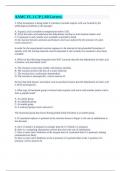
-
AAMC FL 1 C/P || All Correct.
- Exam (elaborations) • 6 pages • 2024
-
- $10.69
- + learn more
2. What assumption is being made if scientists conclude aspartic acid was formed by the prebiological synthesis in the passage? A. Aspartic acid is unstable at temperatures below 150C B. All of the malic acid underwent the dehydration reaction to form fumaric/maleic acid C. Compound A and cyanide were available on primitive Earth D. the reaction between ammonia and fumaric acid was catalyzed by the presence of water. correct answers C. In order for the experimental reaction sequence to...

-
AAMC MCAT PRACTICE 2023 EXAM 1| QUESTIONS & ANSWERS| ALREADY PASSED| VERIFIED & UPDATED
- Exam (elaborations) • 185 pages • 2023
-
- $14.49
- + learn more
AAMC MCAT PRACTICE 2023 EXAM 1| QUESTIONS & ANSWERS| ALREADY PASSED| VERIFIED & UPDATED In the chromatography of the reaction mixture, water absorbed on cellulose functioned as the stationary phase. What was the principal factor determining the migration of individual components in the sample? A) Hydrogen bonding B) Solute concentration C) Stationary phase concentration D) Thickness of paper - ANSWER A) Hydrogen bonding The answer to this question is A because the relative amount of hy...
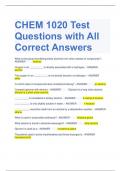
-
CHEM 1020 Test Questions with All Correct Answers
- Exam (elaborations) • 8 pages • 2024
-
Available in package deal
-
- $13.29
- + learn more
CHEM 1020 Test Questions with All Correct Answers What is the group that distinguishes alcohols from other classes of compounds? - ANSWER hydroxy Oxygen in an __________ is directly associated with a hydrogen. - ANSWER alcohol The oxygen in an __________ is not directly bound to a hydrogen. - ANSWER ether To which class of compounds does cholesterol belong? - ANSWER an alcohol Compare glycerol with ethanol. - ANSWER Glycerol is a long chain alcohol, ethanol is a short chain alcohol....
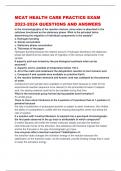
-
MCAT HEALTH CARE PRACTICE EXAM 2023-2024 QUESTIONS AND ANSWERS
- Exam (elaborations) • 50 pages • 2024
-
- $19.49
- + learn more
MCAT HEALTH CARE PRACTICE EXAM QUESTIONS AND ANSWERS In the chromatography of the reaction mixture, since water is absorbed in the cellulose functioned as the stationary phase. What is the principal factor determining the migration of individual components in the sample? a. Hydrogen bonding b. Solute concetration c. Stationary phase concetration d. Thickness of the paper Hydrogen bonding because the relative amount of hydrogen bonding to the stationary phase will determine the relative r...
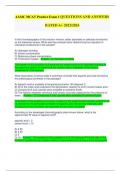
-
AAMC MCAT Practice Exam 1 QUESTIONS AND ANSWERS RATED A+ 2023|2024
- Exam (elaborations) • 61 pages • 2023
-
- $13.49
- + learn more
AAMC MCAT Practice Exam 1 QUESTIONS AND ANSWERS RATED A+ 2023|2024 In the chromatography of the reaction mixture, water absorbed on cellulose functioned as the stationary phase. What was the principal factor determining the migration of individual components in the sample? A) Hydrogen bonding B) Solute concentration C) Stationary phase concentration D) Thickness of paper - Answer - A) Hydrogen bonding The answer to this question is A because the relative amount of hydrogen bonding to t...
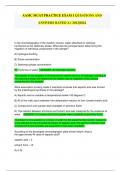
-
AAMC MCAT PRACTICE EXAM 1 QUESTIONS AND ANSWERS RATED A+ 2023|2024
- Exam (elaborations) • 94 pages • 2023
-
- $14.49
- + learn more
AAMC MCAT PRACTICE EXAM 1 QUESTIONS AND ANSWERS RATED A+ 2023|2024 In the chromatography of the reaction mixture, water absorbed on cellulose functioned as the stationary phase. What was the principal factor determining the migration of individual components in the sample? A) Hydrogen bonding B) Solute concentration C) Stationary phase concentration D) Thickness of paper - ANSWER A) Hydrogen bonding The answer to this question is A because the relative amount of hydrogen bonding to the...
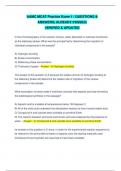
-
AAMC MCAT Practice Exam 1 | QUESTIONS & ANSWERS| ALREADY PASSED| VERIFIED & UPDATED
- Exam (elaborations) • 91 pages • 2023
-
- $15.49
- + learn more
AAMC MCAT Practice Exam 1 | QUESTIONS & ANSWERS| ALREADY PASSED| VERIFIED & UPDATED In the chromatography of the reaction mixture, water absorbed on cellulose functioned as the stationary phase. What was the principal factor determining the migration of individual components in the sample? A) Hydrogen bonding B) Solute concentration C) Stationary phase concentration D) Thickness of paper - Answer - A) Hydrogen bonding The answer to this question is A because the relative amount of hydr...
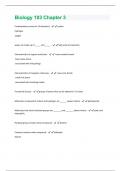
-
Biology 103 Chapter 3 Questions And Answers Graded A+
- Exam (elaborations) • 5 pages • 2024
-
- $7.99
- + learn more
Carbohydrates consist of: (3 elements) - carbon hydrogen oxygen waxes are made up of _____ and _____ - fatty acids and alcohols Characteristics of organic molecules - -have covalent bonds -have many atoms -associated with living things Characteristics of inorganic molecules - -have ionic bonds -small # of atoms -associated with nonliving matter Functional Groups - groups of atoms that can be added to C-H chains Molecules composed of carbon and hydrogen are ______ (water haters) - Hydr...
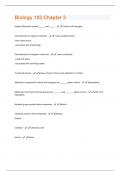
-
Biology 103 Chapter 3 (Questions + Answers) Verified 100% Correct!!.
- Exam (elaborations) • 5 pages • 2024
- Available in package deal
-
- $7.99
- + learn more
Organic Molecules contain _____ and _____ - Carbon and Hydrogen Characteristics of organic molecules - -have covalent bonds -have many atoms -associated with living things Characteristics of inorganic molecules - -have ionic bonds -small # of atoms -associated with nonliving matter Functional Groups - groups of atoms that can be added to C-H chains Molecules composed of carbon and hydrogen are ______ (water haters) - Hydrophobic Molecules that have functional groups are _______ and ____...

Did you know that on average a seller on Stuvia earns $82 per month selling study resources? Hmm, hint, hint. Discover all about earning on Stuvia


